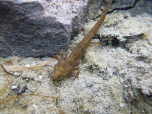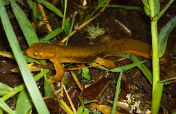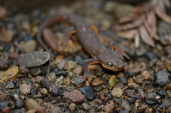Northern Rough-Skinned Newt (T. g. granulosa)
Description: A stocky, large-bodied salamander. Dorsal coloration varies from light brown to blackish brown. The venter is light yellow to orangish red. Upper and lower eyelids are dark. The iris is yellow and the eyes are relatively small. This species has a dry, warty skin, except in mating season when adult males develop a smooth, even slimy, skin. The skin of both males and females is lighter colored during the mating season. Adults are 5.6 to 8.7 cm snout to vent length (12.5 to 22 cm total length). Some populations have adults which retain gills.
Habitat: Terrestrial habitat is forests in hilly or mountainous areas, occasionally grasslands or pastures. Aquatic habitat includes seasonally ephemeral ponds, as well as lakes and sluggish areas of streams. Rarely found in fast-flowing water.
Range: This species ranges from southwestern Alaska, along the coast of North America through British Columbia, Canada, Washington, Oregon, and California to the San Francisco Bay area.
Found in these States:
CA |
OR
Diet: Prey of adults includes aquatic and terrestrial invertebrates, and also amphibian larvae and eggs.
Reproduction: Rough-skinned newts migrate annually to and from their aquatic breeding sites. Migration occurs primarily in rainy weather when the temperature is >5º. Breeding season varies with latitude, and has been recorded over most months of the year with a peak from March to early May. Courtship includes a period of amplexus of the female by the male. During amplexus, the male rubs his head over the females. Fertilization is internal by means of a spermatophore, deposited by the male on the substrate and picked up by the female in her cloaca. Oviposition takes place shortly after mating. Eggs are laid singly, attached to submerged vegetation, rootlets, or detritus.
Status: Listed as Least Concern in view of its wide distribution, presumed large population, and remaining suitable habitat across its range.
»» Kingdom: Animalia - Animals
»» Phylum: Chordata - Chordates
»» Subphylum: Vertebrata - Vertebrates
»» Class: Amphibia - (Amphibians)
»» Order: Caudata - Salamanders
»» Family: Salamandridae - Newts
»» Subfamily: Pleurodelinae - Pleurodeline Newts
»» Genus: Taricha
»» Species: Taricha granulosa - Rough-Skinned Newt
»» Subspecies: T. g. granulosa - Northern Rough-Skinned Newt
This article uses material from the Wikipedia article "Rough-Skinned Newt", which is released under the Creative Commons Attribution-Share-Alike License 3.0. Content may have been omitted from the original, but no content has been changed or extended.
|













